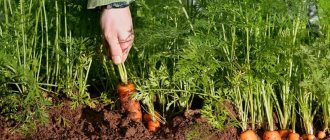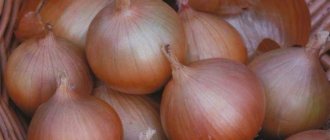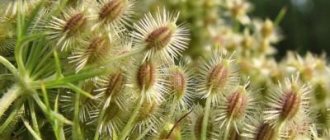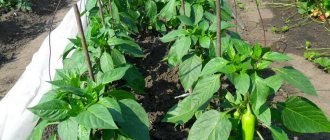Vegetable growing » Carrots
0
993
Article rating
Kira Stoletova
Moscow winter carrots are a mid-season, high-yielding variety. Studying the characteristics of the Moscow winter variety and the rules for its cultivation allows you to take care of the vegetable and get a good harvest.
Moscow winter carrots
Detailed characteristics and description of the variety
- Appearance . Moscow winter is a long, blunt-ended cylindrical root crop. Carrots are almost smooth and have only small eyes. The color is bright orange; the head may change color to green or purple at the end of the growing season. Length 15-18 cm. It has a rounded core, small in size, the flesh is sweet and juicy.
- What variety does it belong to ? Moscow carrots belong to the Chantenay variety. Carrots of this variety have a pleasant sweet taste. The fruits do not exceed 20 cm in length, have a rounded center and a blunt nose.
- Amount of fructose and beta-carotene . The amount of fructose in Moscow winter varies from 7 to 8%, the amount of carotene does not exceed 13 mg.
- Sowing time . They begin to plant Moscow winter when the air temperature drops to 5 degrees.
- Seed germination . The germination rate of this variety is about 85% of the total number of seeds.
- Average weight of 1 root vegetable . The average weight of a root crop is about 90-170 grams.
- What is the yield from 1 hectare . The average yield from 1 hectare is about 30 tons. The maximum is about 100 tons.
- Purpose of the variety and keeping quality . Moscow winter is used both for long-term storage or twisting, and for fresh consumption. Keeping quality is good; this type of carrot, if stored correctly, survives the entire winter period without problems.
- Growing regions . This variety of carrots can be grown anywhere in Russia, as well as Belarus and Ukraine. Most often it is used for sowing in places with a cold climate, for example, in the Leningrad region, the Urals, Siberia or the Moscow region.
- Where is it recommended to grow . Carrots are grown in open ground, in very cold winters, and are additionally insulated with peat.
- Resistance to diseases and pests . Moscow winter carrots have average resistance to pests and crop diseases.
- Maturing period . The ripening period varies from 60 to 120 days depending on air and soil temperatures. Read about the ripening times of other carrot varieties.
- What types of soil does he prefer ? This carrot variety prefers well-drained, neutral soil. The soil temperature should not be more than 7 degrees when planting seeds.
- Frost resistance . The seeds of this carrot are frost-resistant and are not afraid of low temperatures, but the seedlings can withstand temperatures of no more than -4 degrees, so in regions with harsh winters, carrot beds should be insulated with peat.
Diseases and pests
The main pests of Moscow carrots:
- umbrella psyllid;
- carrot fly;
- cabbage butterfly.
Carrots are slightly susceptible to diseases, but they manifest themselves:
- Alternaria blight is a fungal disease that manifests itself in the form of mold and spots.
- Phomasis is a disease caused by the fungus Thomas Rostrup. In the area where the disease was discovered, carrots are replanted only after 4 years.
Treatment of diseases
Fertilizing with potassium and treating the beds with a 1% solution of Bordeaux mixture helps to cope with fungal diseases.
Getting rid of pests
To combat the umbrella psyllid and carrot fly, the seeds are planted as early as possible and covered with non-woven material - lutrasil. The drugs Intavir and Actellik help fight carrot flies.
When cabbage appears, the crops are covered.
What is the difference from other types?
Moscow winter carrots are unpretentious. It is planted in all regions of the country, regardless of climate. It has resistance to parasites and diseases, as well as excellent keeping quality. Unlike its counterparts, it takes root well in almost any soil.
Moscow winter carrots also have a large amount of carotene, which is preserved even when the carrots lie in the cellar for a long time. This variety is suitable both for fresh consumption and for twists, salads, and storage.
Buying carrot seeds for winter sowing
in the photo: dry carrot seeds for winter sowing
Carrots from pre-winter sowing will not be stored during the winter, so we are more interested in early ones, which show themselves well as “bunch” products.
Excellent results are obtained from varieties and hybrids of the Nantes variety type (with a cylindrical root shape, a blunt tip and lush tops). But others can be used as well. Seeds will be required 20-25% more than with spring sowing (approximately 1 g per sq. m).
Dried and “ribbon” seeds are not suitable - only regular ones that have not undergone any processing. The fresher the seeds, the better.
Advantages and disadvantages
Flaws:
- Moscow winter carrots do not tolerate dry periods;
- takes a long time to germinate.
Advantages:
- resistance to diseases and parasites;
- color resistance;
- keeping quality (carrots can wait until summer);
- high yield (per 1 sq.m. approximately 5-7 kg);
- taste qualities of root vegetables and presentation of carrots;
- unpretentiousness;
- seeds are sown both in spring and before winter.
Reviews about the Moscow winter carrot variety A 515
Amateur summer residents and farmers characterize the variety as easy to grow, producing a harvest with excellent taste and keeping well in the cellar during the winter.
Svetlana, Krasnodar : “For several years I was going to try to plant carrots before winter. Last year I decided. I planted the Moscow winter variety A 515. I really liked the result. The carrots grew tasty and juicy.”
Evgeniy, Saratov : “Relatives shared the seeds of Moscow winter carrots. For comparison, I planted the seeds in November and April. The winter seeds sprouted a little earlier. They grew up the same way. I collected a lot of vegetables. I liked the taste."
Irina, Moscow region : “I liked planting Moscow winter carrots A 515 for the winter. The main thing is to cover the beds well. In spring, do not rush to water. The soil takes a long time to dry after snow. I liked the harvest because of its quantity and quality – the root crops are tasty and juicy.”
Features of cultivation
Moscow winter carrots are planted after cucumbers and zucchini , or at the end of October, when the average daily temperature drops to 5 degrees. It is advisable that the area is well illuminated by the sun, the soil should be fertile and not acidic, this will help achieve a larger harvest.
Moscow winter will give the best results on cultivated loam. The seeds tolerate both snowy and snowless winters well. When planting in winter, the ground needs to be mulched, but in spring you will need both mulch and irrigation.
How to sow carrots before winter?
Autumn sowing of carrots differs significantly from spring sowing. The difference lies not only in the timing of the work, but also in the features of the technology. Pre-winter sowing involves selecting the desired site, preparing the soil and planting material. After the grains are at the required depth, they must be covered, protecting them from the cold. It is also prohibited to water the garden bed. Cultivation of winter carrots, despite the risks of losses, is advantageous in that after sowing the area does not require special care until spring.
Important! You should not plant carrots in the same bed every year. There should be a 3-year pause between such plantings.
Site selection and soil preparation
Carrots are considered an unpretentious vegetable crop. It can adapt to different soil and climatic conditions, but to obtain a good harvest, it is recommended to improve the external factors of its cultivation. First of all, the gardener should pay attention to the sowing location.
When choosing it, it is preferable:
- flat, well-lit areas;
- loamy and sandy loam soils (it is desirable that the soil composition contains at least 4% of nutrients, for example, humus);
- neutral acidity of the substrate.
Important! Acidic soils are neutralized by adding wood ash, dolomite flour or well-known fluff (at the rate of 150–300 g/m², depending on the Ph level).
Having decided on the area for sowing, you can begin preparing it. At this stage it is important:
- In September, before deep plowing the site, fertilize the soil, depending on its fertile qualities. For example, in clayey, loamy and podzolic areas, it is advisable to add a mixture of equal parts of river sand, sawdust, humus and high peat. About 5 kg of fertilizer should be applied to each square meter. If you want to improve the fertility of the substrate, you can add superphosphate and nitrophoska at the rate of 0.02 kg/m². On sandy beds, a mixture of turf soil, peat and compost in a ratio of 2:2:1 will not be superfluous. You can also use mineral complex formulations for vegetable crops. It is enough to enrich the composition of the chernozem area with superphosphate at the rate of 2 tbsp. spoons per 1 m².
- After adding nutrients, the garden is dug up. When loosening the soil, do not turn over fertile blocks, as such actions can cause disruptions in soil biosystems. It is better to cultivate the bed with a cultivator or hoe, going 20–30 cm deep.
- After plowing, use a rake to level the surface of the area and leave it until frost sets in. In order to protect crops from stagnation of water and freezing, it is recommended at this stage to raise the bed by 15 cm and fix this level with wooden sides of the appropriate height. The design will be useful when covering plantings for the winter.
- After a month and a half, when the ground is still moist and warm, prepare furrows up to 3–5 cm deep, keeping the interval between them within 20 cm.
Preparation of planting material
Good germination requires high-quality seeds, so many practitioners advise giving preference to purchased material that has been panned and treated with growth stimulants. If you have to deal with homemade preparations, then the grains are pre-soaked in cold water to select promising samples.
Did you know? Taking into account the fact that each person must eat at least 8 kg of carrots annually to maintain health, this vegetable is second only to potatoes in popularity among Europeans.
As a rule, they settle to the bottom, and the husks unsuitable for planting float to the surface. It is drained along with the liquid. After this, the seeds are poured with a growth-stimulating solution (Kornevin, Ecosil) and dried thoroughly. All manipulations must be carried out long before sowing, so that the planting material has time to dry well. After all, even slight moisture will further provoke rotting or freezing.
Planting pattern and depth
Autumn sowing of carrots is not much different from spring sowing. After waiting until the average air temperature drops to a stable +5°C, dry seeds are distributed into the furrows made in advance without pre-moistening. The distance between them should be about 3 cm. Make sure that the depth of the rows is 4–5 cm. If for some reason it becomes smaller, renew the furrows. For convenience, it is recommended to mix prepared grains with dry soil (it is collected in September after fertilizing the beds).
Other vegetable growers use paper tape with seeds glued to them when planting winter carrots. However, the latter method is ineffective due to the paste present (with excess moisture, the grains germinate prematurely and die at the first frost). It is important that the crops are planted in frozen substrate during a period when no future warming is expected. At the final stage, the rows are sprinkled with soil and compacted. The bed is covered with plastic film, fixing its edges.
Why plant carrots before winter?
Carrots develop better in beds where the following were planted the previous year:
- potato;
- legumes;
- cabbage;
- tomatoes.
Fennel, dill, parsley, caraway seeds, celery and carrots are considered bad precursors for vegetable crops.
Read more about what crops to plant carrots in open ground after.
Harvest and storage
It is not difficult to understand whether the fruit is fully ripe. After ripening, the root crop becomes overgrown with small roots, its color becomes red-orange. It is easily pulled out of the ground. Most often, ripening occurs in mid or late September.
The harvest should be harvested in dry weather before the first frost. Moscow winter is sensitive to mechanical damage; damaged carrots will not be stored for long. The tops are cut off immediately. Carrots intended for long-term storage should not be washed or cleaned of dirt .
After harvesting, the carrots are placed in a well-ventilated area to dry, and then transferred to a cool, dark room for 5-6 days. After this procedure, the carrots can be placed in boxes and sent for permanent storage in a barn or cellar.
Beauty Maiden
Carrots are high in vitamins. It is used for fresh summer salads and is suitable for pickling. The pulp is bright orange, the middle has high taste characteristics. The fruits are medium in size, with a blunt end.
Related article:
Ten Methods for Sowing Carrot Seeds
Pre-winter sowing is carried out a week before the onset of frost. It is not worth sowing earlier, as the seeds will have time to start growing and produce the first leaves, which will be damaged by frost. It is not recommended to store this variety; it is best to consume it within a month.
Problems during cultivation and ways to solve them
Corrupted by rot
Carrots affected by rot are not suitable for food; such root vegetables should be destroyed . Under no circumstances should carrots affected by rot be left in storage; they will continue to rot and infect other root vegetables.
If carrots are susceptible to rot, you should take preventive measures before planting next year:
- Treat the seeds before sowing.
- Reduce soil acidity and fertilize to make the soil more fertile.
- Change the place where carrots are sowed.
- Thin out the crops in time.
- When watering crops, the beds should not be either over-dried or over-watered.
- Avoid fertilizing with nitrogen; it is better to use phosphorus-potassium fertilizers.
- A month before harvesting, plants should be treated with Bordeaux mixture.
Cracks in root crops
The problem with cracks is that carrots look less appetizing and cannot be stored for long.
- In order to put the soil in order, use sapropel.
- Watering should be done 2-3 times a week, but so that the soil is saturated to 20-25 cm.
- Avoid using nitrogen fertilizers.
Unusual shape
Such vegetables are edible and do not lose their taste, but they are poorly stored. To avoid changing the shape of carrots you need :
- Avoid applying fresh manure before planting.
- Make the soil fertile.
- Water carrots 2-3 times a week.
Excess roots
“Hairy” carrots do not lose their taste and are allowed for consumption, but they will not be stored for a long time.
To get rid of excessive root growth, it is enough:
- While loosening the ground.
- Adjust watering.
- Make the soil more fertile.
Bitter taste
If the carrots have grown bitter, it means that the technique for caring for them has been violated. To make carrots sweet and juicy, you need :
- During hilling.
- Set up watering.
- Don't forget about thinning.
- Root crops that have come out of the ground should be covered with earth.
You don't have to be an experienced gardener to grow carrots. You just need to follow all the rules for planting and care. We will help you grow the following varieties of these root vegetables in your garden: Nandrin, Alenka, Nantes 4, Forto, Champion, Queen of Autumn, Red Giant, Boltex, Abaco and Dordogne.
Features of further planting care
Further care of the sown carrots consists of timely weeding of the plants, regular watering, fertilizing, loosening the soil and pest control. All these activities directly affect the quantity and quality of the harvest.
Feeding and watering scheme
Watering and fertilizers play a very important role in the formation of root crops and improving the taste properties of Moscow winter carrots. It is necessary to water the garden bed in a timely manner ; It is advisable to adhere to the same time intervals, so that the root crops will form correctly, have a beautiful presentation and good taste.
The first watering is carried out after sowing carrots in open ground using a spray bottle (so as not to wash the seeds out). During this period, it is necessary to maintain soil moisture for better germination by covering the bed with plastic film or mulch with a layer of 5–10 cm (hay, compost, peat, etc.). When the first shoots appear, watering is carried out every 2-3 days, with a calculation of 5-6 liters of water per 1 m² of land (the water must be warm and settled). Additionally, the beds are watered after thinning the plants.
During the formation of root crops (in June), watering is carried out once a week, 10–12 liters per 1 m² of bed. Later, you need to water the beds once every 10 days, 15–20 liters per 1 m².
Important! Watering should be stopped 2-3 weeks before harvesting so that the carrots can be stored longer and do not spoil.
Fertilizer application:
- The first fertilizing is carried out when 2 leaves are formed on the plant. To do this, you can take 30 g of potassium salt, 25 g of ammonium nitrate, 30 g of superphosphate and dilute it in 10 liters of water. This solution is consumed per 10 m² of bed.
- The second feeding is carried out after thinning the carrots, using the same solution or “Nitrophoska” (1 tablespoon per 10 liters of water), “Solution” (60 g per 10 liters of water).
- The following fertilizing is introduced during the growth period of root crops to increase their taste, especially sugar content. Use dry ash or an infusion of wood ash (infuse 2 cups per 10 liters of hot water for 2 days).
- The latter is carried out 3 weeks before harvest using humates.
Thinning of plantings
This procedure can be done when the seedlings have 2 true leaves . The interval between seeds should be 3 cm. The next thinning is carried out 3-4 weeks after the first, if there are 4-6 true leaves on the plants; A distance of 5-6 cm is left between the root crops.
Read more about how to properly thin carrots in open ground.
Loosening and weed control
Weeding and loosening of the soil is done after watering and after each thinning of carrots. At first, these activities must be done very carefully so as not to damage the root crops, which germinate much later than the weeds. Next, when the fruits are formed, in addition to loosening and weeding, you need to hill up the rows, covering the tops of the root crops and preventing them from greening.
Pest and disease control
Most often, Moscow winter carrots are exposed to the following pests and diseases:
- umbrella psyllid is an insect that causes harm to carrots in the form of curling and deformation of leaves. It is recommended to treat plants with Decis (2 ml per 10 liters of water), Kinmiks (2.5 ml per 10 liters of water);
- carrot fly - the larvae of this pest infect root crops, as a result of which they become unfit for consumption. You need to fight them by adhering to crop rotation and treating with a decoction of yarrow (1 kg per 10 liters of water), a decoction of wormwood (2 kg per 10 liters of water), and the drug “Fitoverm” (10 ml per 5 liters of water);
- Alternaria is a fungal disease that manifests itself in the form of mold and spots. Preventive methods include maintaining crop rotation and purchasing high-quality seed. For treatment, the chemical preparations “Fitosporin” (6 g per 10 liters of water), “Gamair” (10 tablets per 10 liters of water) are used;
- phomosis is a disease that affects the tops and roots of carrots in the form of gray-black spots. Crop rotation and clearing the area of weeds help prevent weeds from appearing. They also use such products as 1% Bordeaux mixture, 5% Fundazol solution.
Similar types of vegetable
- Variety "Niioh 336" This variety is similar to the Moscow winter variety in shape, length and weight, also has excellent keeping quality and high carotene content. Gives an excellent harvest.
- The “Emperor” variety, like the Moscow winter variety, is resistant to flowering, is stored until the summer, and produces a high yield. It has sweet and juicy flesh and sizes up to 170 cm.
- The “Samson” variety ripens within 120 days after planting, is well stored, the average length is about 150 cm. The root crops are sweet and juicy. The variety is unpretentious and resistant to diseases and parasites.
- The “Gyulchatai” variety retains its beneficial properties for a long time, is stored for a long time, and is suitable for any type of processing, as well as long-term storage and fresh consumption.
The Moscow winter season was in vain forgotten by gardeners. It has many advantages and contains a large amount of vitamins. It can be used anywhere, in twists, baby food, daily cooking. Proper care and timely planting and harvesting will help achieve high yields. These carrots will delight you all winter.
If you find an error, please select a piece of text and press Ctrl+Enter.
Selection according to region
In order for crop cultivation to be successful, when choosing a variety it is important to take into account the climatic characteristics of the region
For the Urals and Siberia
Today, many varieties have been bred that are suitable for growing in harsh climates. These include:
- Dayana - the fruits ripen 4 months after the sprouts appear. Root vegetables are distinguished by their elongated shape with sharp tips. They weigh 150 grams.
- Nastena - it is characterized by even and smooth root crops that can grow up to 17-19 centimeters. The weight of carrots is approximately 150 grams. Inside there is a thin and short middle.
- Narbonne f1 - the harvest can be obtained within 3.5 months after planting. The culture is characterized by elongated fruits, which are distinguished by rounded tips. They reach 22 centimeters in length. The mass of carrots is 240 grams.
For the Moscow region
This region is characterized by cool summers and the risk of return frosts. Therefore, in the Moscow region it is worth planting carrots, which are resistant to weather changes and precipitation. Suitable crops include:
- Amsterdam - considered one of the best early types of culture, which has a long shelf life. It is permissible to keep the harvest in the cellar all winter.
- Children's joy - this crop has excellent taste. It is characterized by a medium period of maturation. The length of the root crops reaches 22 centimeters. Moreover, their weight is 160 grams.
- Vitamin - culture has an average ripening period. There is a small core inside the fruit. Carrots reach a length of 14-15 centimeters. Moreover, its weight is 70-150 grams. The plant is highly resistant to frost.
For the middle band
Not all types of carrots can be grown in this climate. This region has variable weather. In addition, it is characterized by high rainfall. Therefore, carrots must be resistant to diseases and low temperatures. Popular varieties include:
- Karotel - the fruits are small in size and have a sweet taste. The plant is characterized by increased resistance to disease. The harvest can be obtained within 4 months after planting.
- Flakke - this Polish variety is suitable for central Russia. Ripe fruits contain a lot of sugar and carotene. They reach a weight of 200-250 grams.
- Moscow winter - is resistant to flowering. The plant develops well in loose, fertile soil and requires systematic watering. The crop is characterized by high yield parameters.
Queen of Autumn
Carrots of this late-ripening variety are a real “queen” among their peers - they are large, regular in shape, bright orange and very well adapted for long-term storage. The plant can tolerate frosts down to –4°C and produces a good harvest. The pulp of root vegetables is juicy and sweet, so they make delicious juice. These carrots can also be eaten fresh, added to soups and salads, or canned.
| Purpose | Growing | Ripening time (days) | Fruit weight (g) | Productivity (kg/sq.m) |
| 117-130 | 60-180 | 3,8-9 | ||











